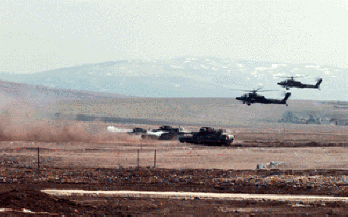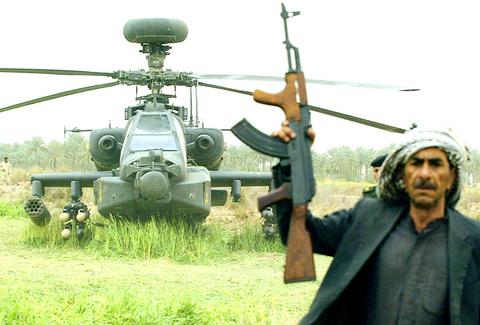Attack helicopters are not strike aircraft, something the Iranians learned the hard way during their war against Iraq in the 1980s. Strike aircraft use high-speed to avoid Anti-Aircraft Artillery (AAA) in low level attacks, or they remain out of range at high altitude and drop "smart" munitions. Slow attack helicopters must rely on ground forces to coordinate their attacks to limit their exposure to enemy AAA. In a proper combined arms operation, attack helicopters are called to support ground forces. The helicopters hover over friendly forces as they provide supporting fires at a safe stand-off range.
This concept was confused by the 1991 Persian Gulf war. Iraq had accepted UN demands and ordered an immediate retreat from Kuwait. After Iraqi Generals fled, Iraqi units rushed northward in panic while American AH-64 Apache attack helicopters joined a "turkey shoot" at the disorganized rabble. The open terrain afforded these attack helicopters a clear view of the area below to ensure safety. This led some amateurs to call the Apache an ultimate tank killing machine.
 These favorable conditions will not
exist in most conflicts. During 1999, the US military wisely decided not to employ AH-64 Apache helicopters as strike
aircraft in the Kosovo campaign. The Yugoslav Army was not in a panic
retreat when Apaches were deployed to nearby Albania. More importantly, the
terrain in Kosovo is mountainous and forested, which does not permit easy
satellite and aerial reconnaissance.
These favorable conditions will not
exist in most conflicts. During 1999, the US military wisely decided not to employ AH-64 Apache helicopters as strike
aircraft in the Kosovo campaign. The Yugoslav Army was not in a panic
retreat when Apaches were deployed to nearby Albania. More importantly, the
terrain in Kosovo is mountainous and forested, which does not permit easy
satellite and aerial reconnaissance.
Apaches may have been successful in Kosovo, but not without a heavy price. Yugoslav AAA gunners would have shot down several Apaches as they attempted to identify and engage hidden targets. On the other hand, strike aircraft were unable to destroy the enemy without friendly ground forces to flush them out into the open. Yugoslav military losses were minor, as revealed in Chapter 5.
Attack helicopters can conduct strafing attacks using their turreted automatic cannon and rockets, but accuracy is difficult and their slow speed exposes them to ground fire. Attack helicopters are extremely effective when they come to a hover for several seconds to employ guided missiles like the TOW or Hellfire. This exposes them to ground fire, but pilots are trained to remain a safe 2000 meters from the target and above friendly forces or open terrain for protection. A pilot who hovers above unknown hostile terrain is asking for trouble. This was quickly learned by Apache pilots in Afghanistan and Iraq, where dozens of Apaches were heavily damaged or shot down.
 The US Army's only disastrous operation during the 2003 invasion of Iraq occurred when
33 Apache helicopters flew forward of the 3rd Infantry Division to attack an Iraqi Republican Guard regiment in the suburbs of Karbala.
After meeting heavy fire from AAA, small arms, and rocket-propelled
grenades, the Apaches flew back to base. Thirty Apaches had been shot up,
several so badly they were scrapped. One Apache was shot down and its two
crewmen taken prisoner.
The US Army's only disastrous operation during the 2003 invasion of Iraq occurred when
33 Apache helicopters flew forward of the 3rd Infantry Division to attack an Iraqi Republican Guard regiment in the suburbs of Karbala.
After meeting heavy fire from AAA, small arms, and rocket-propelled
grenades, the Apaches flew back to base. Thirty Apaches had been shot up,
several so badly they were scrapped. One Apache was shot down and its two
crewmen taken prisoner.
After that incident, Apaches were used cautiously, only on reconnaissance missions or for firing at small groups of armored vehicles. Rarely did they operate in front of US ground troops or without the escort of fixed-wing aircraft flying overhead. US Marine Corps Cobra attack helicopters also suffered from ground fire, so they too were limited to operating at top speed or at stand-off ranges above friendly troops.
Unfortunately, attack helicopter pilots often ignore this reality in peacetime exercises and fly ahead of ground forces to engage targets. As they hover to employ guided missiles, they are often just 50 meters from enemy forces that open fire (with blanks). The pilots ignore the simulated fire below and return to base. In real combat they may die, something attack helicopter pilots and strategists must understand. The open desert and ocean allow helicopter pilots the freedom to safely hover and engage targets in a strike role, but most of the world's surface does not allow a clear view of nearby terrain.
A properly trained AAA gunner will not fire at fast maneuvering attack helicopters, or distant helicopters, or helicopters flying toward them (since they have frontal armor and can immediately identify the AAA threat.) A good AAA gunner will wait in ambush for an attack helicopter to slow to seek or engage targets. When it comes within 1000 meters and presents a clear flank view, the AAA hunter will bag his prey. Effective warfare requires combined arms in which ground forces act as bird dogs to locate targets for heavy firepower. Attack helicopters are not strike aircraft, but a supporting arm to engage targets uncovered by ground forces.
©2015 www.G2mil.com